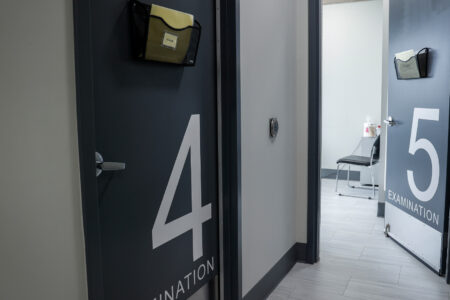
Friday, May 20. After the first game of my annual soccer sea- son, as I got off the dinner table, it dawned on me that my right knee was swollen, painful and very stiff. In order to avoid potentially horrendous wait times, I decided to seek medical attention only if there was no improvement by Monday.
On Tuesday morning (at this point, I could barely put any weight onmyrightleg),Ioptedtogotoa minor care clinic. After a reasonable wait, the generalist who saw me barely examined me and diagnosed a knee sprain. He prescribed crutches and anti-inflammatories and told me to start walking on my leg in a week.
After an uncomfortable week with the crutches, there was no substantial improvement. It was now 11 days from the date of the injury and I thought it best to see a sports medicine orthopaedist. However, every sports medicine clinic I called required a doc- tor’s referral. I was back to square one.
The following Thursday, I ended up doing what I initially wanted to avoid at all cost. I waited five hours in a hospital emergency ward hoping that a generalist would grant me the coveted referral. After a thorough examination, the generalist told me to keep using the crutches and taking the anti-inflammatories. He pre- scribed an immobilization brace and gave me the referral.
The next Thursday (now 20 days since the injury, still on crutches), I saw the sports medicine specialist. The suspicion was that I had a partial meniscus tear and had stretched or partially torn both my medial collater- al and anterior cruciate ligaments. I was told to lose the crutches, start physiotherapy, find out if I was insured to get an MRI at a private clin- ic, and come back in a week for an evaluation. The MRI was required to confirm the preliminary suspicions and decide on a final course of action (surgery or not).
Not ready to endure another week ”” much less another month ”” of this, I went to a private physio- therapy clinic. Luckily, my wife’s employer’s medical insurance policy covered 50 percent of my physio charges. Unfortunately, no such luck for the MRI. The choice was to wait three to six months for a public clinic or a week for a private clinic and fork out $650. My doctor immediately sent an MRI requisition to the hospi- tal that their clinic dealt with. She also informed me (of course, I didn’t hear this from her) that I could ask the receptionist for a copy of the req- uisition in order to fax it to other hos- pitals that might have shorter delays. She even slipped me the name of a hospital rumoured to have a six to eight week delay.
A colleague knew someone on the board of a Montreal area hospital, and made a call on my behalf to see if the process could be expedited if I had the MRI there. I was called back within a week. I was ecstatic, until the appointment was booked for November! Finally, I faxed the requi- sition to the hospital rumoured to have a six to eight week delay. On July 15 (56 days), the hospital called. On July 24, 65 days since my injury, I had an MRI. The following day, the hospital that my clinic dealt with called. Their appointment would have been set for August 3 (76 days), even though they had had my requi- sition for about two months.
Given my situation, I took a keen interest in the Chaoulli case. I was happy that the Supreme Court of Canada made a decision to strike down a Quebec prohibition on pri- vate health care insurance, declaring that barring residents from paying for treatments (albeit indirectly) already covered by medicare contravened rights guaranteed under the Quebec and Canadian charters. I wasn’t happy because I necessarily agreed with the decision.
I was happy because the majority of the court fessed up to its responsi- bility by not averting the question under examination. They made a gutsy decision that calls into question the choices that a patient can exercise and the way certain health care servic- es are delivered. That’s more than can be said of our governments, who only seem capable of engaging in perpetual funding, jurisdictional and cash infu- sion wranglings.
This governmental discourse is devoid of a genuine willingness to examine new ideas about health care delivery. Entertaining new ideas does not necessarily equate with sacrificing publicly funded universal health care. The current discourse perpetuates the status quo and fails to address the dif- ficult human consequences on the ground. It’s high time that our govern- ments and the Canadian public stop discarding ideas for innovating our inefficient health care system under the guise that new ideas will automat- ically lead us away from our sacrosanct values.







